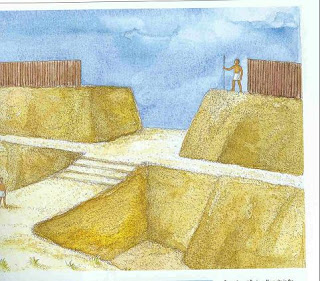Comparing fortifications
This is another chance to reach consensus if we just use common sense. Set aside everything Joseph Smith and Oliver Cowdery said and just look at the options.
Book of Mormon Central (BOMC) cites Becan as the ultimate example of a Nephite fortification created by Moroni. So does FairMormon (and probably all the other affiliates of BOMC). FairMormon gives us 4 images to consider, all of Becan. At least that’s somewhat scientific; BOMC gives us three illustrations of “a fortified Nephite city” (which is actually an unidentified rendition of Becan with the moat Mormon forgot to mention obscured by different coloration), “Captain Moroni’s Works of Timbers,” and “Nephite Fortifications,” all featuring the ubiquitous Mayan stone temples that appear in all the Mesoamerican artwork but not in the text.
Here is the place of entrance at Becan:
Source: Book of Mormon Concensus













